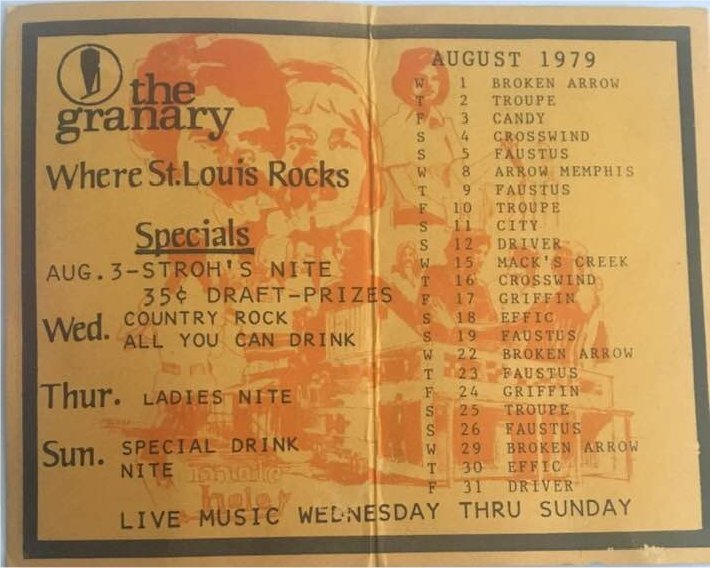
From rock to jazz, from Chuck Berry to the Blues hockey team, music grows like weeds in St. Louis. In the 1970s, the St. Louis area was a live music hub. Bands came from all over the Midwest to hit the Metro East club circuit. During that decade, one of the most exciting destinations was Edwardsville’s The Granary.
Converted from a feed store in 1971, the club opened in March with events booked six nights a week. The tremendous building featured five bars dispersed across 4 floors. At some points in its life, there was a see-through dance floor, a disco ball, and both pizza and sandwiches served from the basement. Headliners were often familiar local favorites, bands like Alice & Omar, or legendary cover band Faustus, who put on an impressive reproduction of “Bohemian Rhapsody”. It was the sounds of The Doobie Brothers and the Eagles—the sounds of the radio—brought to life by a shaggy bunch of local guys you could grab a beer with after the show, and maybe catch tomorrow at the club across town.
Local legends and obscurities alike toured in a manner that made live music possible every night of the week. Groups like Younger Brothers might be in St. Louis’ Animal House (“Live Entertainment and Disco Devoted to Young Adults”) on Wednesday, The Granary on Thursday, and opening for Mama’s Pride all the way in Lebanon, Illinois on Friday. This was the home of the club Stonehenge, another rock and roll behemoth of rural Illinois. Stonehenge matched the Granary’s recipe for success: an old grain warehouse converted to a three-story music venue with a deli in the basement and famously raucous rock music.
The Granary offered what any good rock club should: accessibility to live music in an exciting environment. They pushed boundaries, challenging both dress and fire codes. The dance was primal: slightly rhythmic, utterly unchoreographed, occasionally violent, and always from the heart.
After about a decade, the Granary succumbed to the natural flow of business, descending from its place on top. However, the spirit of rock and roll doesn’t give up easily. The same building reopened under new management as Fat Cats, and St. Louis kept rocking for another decade. The infamous granary building saw its final day in 1989, after Fat Cats closed, and the building was demolished. Today, the location offers a different kind of energy: a QuickTrip stands at the corner of Troy Rd (where the old Highway 159 used to be) and Goshen Road where the club once was.
The Granary was a moment in time. As much a product of its environment as an environment itself, the magic of it existed only in its own present. Within less than 4 decades, one address transformed from a livestock feed store to two renditions of a legendary rock and roll destination, to a gas station. What else does the future hold for what once was The Granary? And what does the future hold for the spaces that are magical to you now?
Editor’s Note: This post has been corrected to indicate the correct former location of The Granary. A previous version mislocated the site.